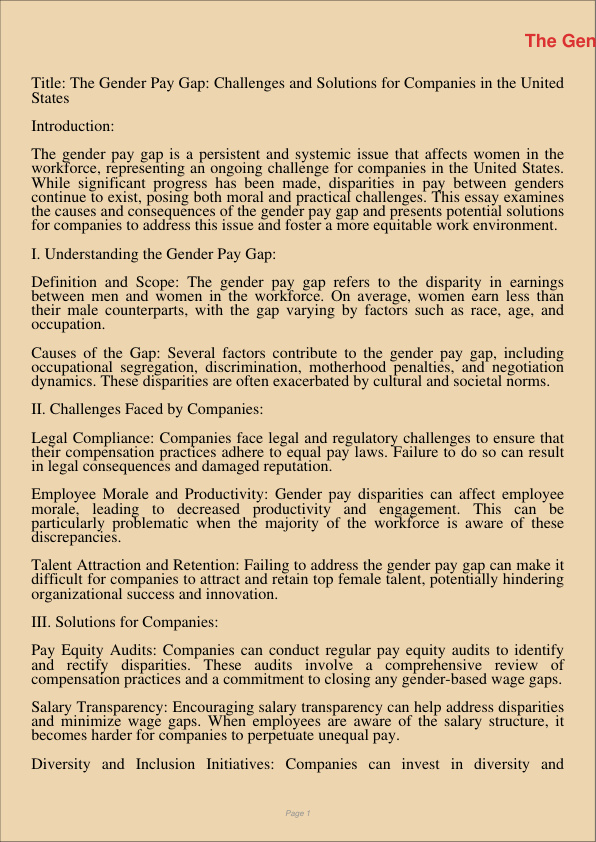
Title: The Gender Pay Gap: Challenges and Solutions for Companies in the United States
Introduction:
The gender pay gap is a persistent and systemic issue that affects women in the workforce, representing an ongoing challenge for companies in the United States. While significant progress has been made, disparities in pay between genders continue to exist, posing both moral and practical challenges. This essay examines the causes and consequences of the gender pay gap and presents potential solutions for companies to address this issue and foster a more equitable work environment.
I. Understanding the Gender Pay Gap:
Definition and Scope: The gender pay gap refers to the disparity in earnings between men and women in the workforce. On average, women earn less than their male counterparts, with the gap varying by factors such as race, age, and occupation.
Causes of the Gap: Several factors contribute to the gender pay gap, including occupational segregation, discrimination, motherhood penalties, and negotiation dynamics. These disparities are often exacerbated by cultural and societal norms.
II. Challenges Faced by Companies:
Legal Compliance: Companies face legal and regulatory challenges to ensure that their compensation practices adhere to equal pay laws. Failure to do so can result in legal consequences and damaged reputation.
Employee Morale and Productivity: Gender pay disparities can affect employee morale, leading to decreased productivity and engagement. This can be particularly problematic when the majority of the workforce is aware of these discrepancies.
Talent Attraction and Retention: Failing to address the gender pay gap can make it difficult for companies to attract and retain top female talent, potentially hindering organizational success and innovation.
III. Solutions for Companies:
Pay Equity Audits: Companies can conduct regular pay equity audits to identify and rectify disparities. These audits involve a comprehensive review of compensation practices and a commitment to closing any gender-based wage gaps.
Salary Transparency: Encouraging salary transparency can help address disparities and minimize wage gaps. When employees are aware of the salary structure, it becomes harder for companies to perpetuate unequal pay.
Diversity and Inclusion Initiatives: Companies can invest in diversity and inclusion programs that foster a culture of equality and respect. These initiatives promote a workplace where all employees, regardless of gender, feel valued and empowered.
Negotiation Training: Offering negotiation training for employees can help level the playing field, as women are often less likely to negotiate their salaries. Empowering all employees with negotiation skills can mitigate gender pay disparities.
Parental Leave and Childcare Support: Offering comprehensive parental leave policies and childcare support can reduce the motherhood penalty and encourage women to remain in the workforce, helping to close the pay gap.
Conclusion:
The gender pay gap remains a critical issue in the United States, posing challenges for both women and companies. Addressing this gap is not only a moral imperative but also a strategic move for organizations seeking to remain competitive and innovative. By implementing solutions like pay equity audits, transparency, diversity and inclusion programs, negotiation training, and support for working parents, companies can take meaningful steps to close the gender pay gap and create a more equitable and productive workplace. Achieving gender pay equity benefits not only women but the entire workforce and society as a whole.
「真诚赞赏,手留余香」
真诚赞赏,手留余香
使用微信扫描二维码完成支付
